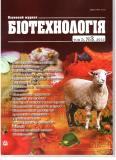ISSN 1995-5537
 "Biotechnology" journal V. 5, No. 3, 2012
"Biotechnology" journal V. 5, No. 3, 2012
Р. 75-83, Bibliography 28, Ukrainian.
Universal Decimal classification: 547.565:542.943.78:546.28:546.212
АNTIRADICAL PROPERTIES OF THIAZOLE DERIVATIVES.
THE EFFECT ON THE METABOLIC ACTIVITY OF YEAST
K. V. Turov, V. M. Barvinchenko,T. V. Krupska, А. А. Тurova, V. S. Brovarets
Institute of Bioorganic Chemistry and Petrochemistry of National Academy of Sciences of Ukraine, Kyiv
Chuiko Institute of Surface Chemistry of National Academy of Sciences of Ukraine, Kyiv
Antiradical activity of the synthesized new derivatives of thiazole in model systems in vitro on DPPH has been studied. It was established that all investigated thiazole derivatives show biological activity but only (5-[(4-tosyl-5-phenylsulfanyl)-1,3-thyazol-2-yl]-1H-tetrazol), 5-chloro-(2-(3,5-dimethyl-1Н-pyrazole-1-yl)-4-thosyl-1,3-thiazole), (7-hydroxy-3-(4,5-ditosyl-1,3-thiazole-2-yl)-2H-chromen-2-on), (5-(4-chlorophenylsulfanil)-4-tosyl-2-phenyl-1,3-thiazole) show the most high activity.
The influence of thiazole derivatives on the metabolism of baking yeast suspension was investigate and, resulting in shows that the carbon dioxide maximum in cells suspension occurs not only in the presents of compounds which exhibit the highest antiradical activity: (5-[(4-tosyl-5-phenylsulfanyl)-1,3-thyazol-2-yl]-1H-tetrazol), (7-hydroxy-3-(4,5-ditosyl-1,3-thiazole-2-yl)-2H-chromen-2-on), but also those who have low activity: (4-tosyl-5-п-chlorophenylsulfanil-2-phenyl-1,3-thyazol), (2,5-di-(4-tolylsulfanyl)-4-tosyl-1,3-thyazole).
It was shown that in the nanocomposite systems of thiazole derivatives with high dispersed silica the release of bioactive substances in the environment can be slowing down. It provides ways to create drugs with programmable release of active substance in a defined area of the gastrointestinal tract.
Thus, it can adjust antiradical properties of thiazole derivatives and predict their biological activity by introducing substituents defined type or changing their position. It allows to create bioactive composite materials with nanostructured mineral matrices, including nanosilica.
Key words: antiradical activity, diphenilpycrilhydrazil, thiazole derivatives, nanosilica, Saccharomyces cerevisiae suspension.
© Palladin Institute of Biochemistry of National Academy of Sciences of Ukraine, 2008

